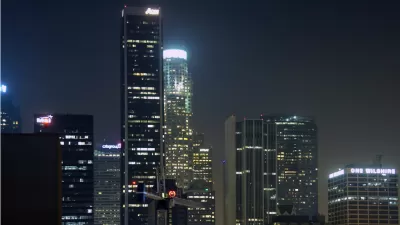Forbes Magazine reflects on the importance and impacts of light-emitting diode (LED) lights as more cities replace their traditional streetlamps with LEDs.
Los Angeles's Bureau of Street Lighting has been busy in the last five years, spending $57 million to replace 155,000 streetlamps with light-emitting diode (LED) lights. With 60,000 more to go, most of them being tricky decorative lights, the city will spend $50 million more. Los Angeles is at the forefront of an often overlooked and seldom discussed factor of urbanization, light pollution.
With more cities and businesses requiring light for commercial or safety purposes, the effects of lighting can lead to surges in electricity consumption, destruction of environment and wildlife, and elimination of the starry nights that have inspired humanity for thousands of years.
A recent article in Forbes Magazine by Ucilia Wang focuses on the importance and potential impacts of lighting cities with LEDs. In recent years, LEDs have proven to more cost effective than regular high-pressure streetlamps, as they "last three to four times longer and produce two to three times more light per watt, delivering anywhere from 30% to 70% in annual electricity savings...they’re also far more programmable and connect more efficiently with radio and sensor chips to create citywide wireless networks to monitor crime, power outages and water main breaks and coordinate disaster relief."
Wang also explains how LED streetlamps can use less light by connecting to motion sensors, and thus eliminating waste. On average, forty percent of any given city's electricity needs powers street lighting, and nearly fifty percent of that is wasted. Aiming to solve this problem, the Danis Outdoor Lighting Lab, or DOLL Lab, located outside of Copenhagen, is already pioneering motion-sensing LED streetlamp experiments in their living lab.
As previously covered in Planetizen, changing from traditional streetlamps to LED lights not only saves municipalities millions each year, but also benefits cinematography.
FULL STORY: How LEDs Are Going To Change The Way We Look At Cities

Planetizen Federal Action Tracker
A weekly monitor of how Trump’s orders and actions are impacting planners and planning in America.

Congressman Proposes Bill to Rename DC Metro “Trump Train”
The Make Autorail Great Again Act would withhold federal funding to the system until the Washington Metropolitan Area Transit Authority (WMATA), rebrands as the Washington Metropolitan Authority for Greater Access (WMAGA).

The Simple Legislative Tool Transforming Vacant Downtowns
In California, Michigan and Georgia, an easy win is bringing dollars — and delight — back to city centers.

The States Losing Rural Delivery Rooms at an Alarming Pace
In some states, as few as 9% of rural hospitals still deliver babies. As a result, rising pre-term births, no adequate pre-term care and "harrowing" close calls are a growing reality.

The Small South Asian Republic Going all in on EVs
Thanks to one simple policy change less than five years ago, 65% of new cars in this Himalayan country are now electric.

DC Backpedals on Bike Lane Protection, Swaps Barriers for Paint
Citing aesthetic concerns, the city is removing the concrete barriers and flexposts that once separated Arizona Avenue cyclists from motor vehicles.
Urban Design for Planners 1: Software Tools
This six-course series explores essential urban design concepts using open source software and equips planners with the tools they need to participate fully in the urban design process.
Planning for Universal Design
Learn the tools for implementing Universal Design in planning regulations.
Smith Gee Studio
City of Charlotte
City of Camden Redevelopment Agency
City of Astoria
Transportation Research & Education Center (TREC) at Portland State University
US High Speed Rail Association
City of Camden Redevelopment Agency
Municipality of Princeton (NJ)




























